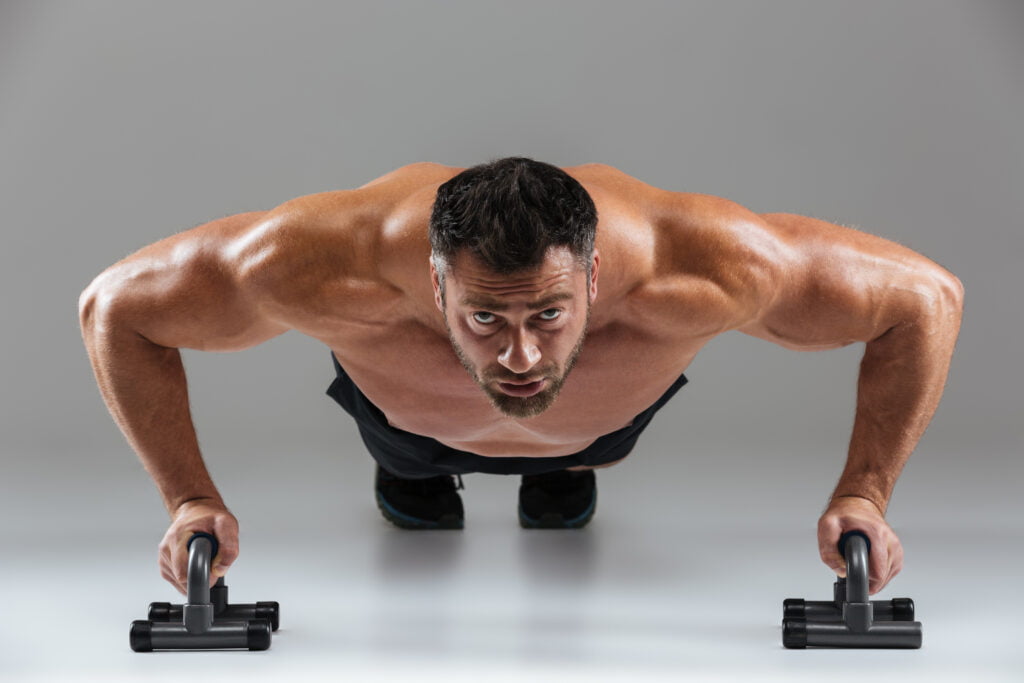Starting a workout routine brings quick wins by targeting certain muscles. Specifically, areas like the biceps and calves can show improvement in a matter of weeks, often increasing in strength by 20-40% in the first month for beginners.
This rapid progress is partly due to these muscles being engaged in daily tasks, thus responding well to additional exercise. Incorporating workouts for these muscles 2-3 times a week not only yields visible results but also boosts motivation.
Muscles that we frequently use, such as the quadriceps from walking or standing, are primed for quicker development. This fast growth sets a strong foundation for overall fitness, making the journey more rewarding right from the start.
Maintaining these gains becomes easier with a consistent and balanced training routine, ensuring long-term fitness success. This introduction aims to guide you on which muscles to target for quick and sustainable growth, enhancing motivation and long-term commitment to fitness.
This rapid progress is partly due to these muscles being engaged in daily tasks, thus responding well to additional exercise. Incorporating workouts for these muscles 2-3 times a week not only yields visible results but also boosts motivation.
Muscles that we frequently use, such as the quadriceps from walking or standing, are primed for quicker development. This fast growth sets a strong foundation for overall fitness, making the journey more rewarding right from the start.
Maintaining these gains becomes easier with a consistent and balanced training routine, ensuring long-term fitness success. This introduction aims to guide you on which muscles to target for quick and sustainable growth, enhancing motivation and long-term commitment to fitness.
Which Muscle In The Body Is Easy To Build?
Building muscle efficiently involves targeting larger muscle groups that are predisposed to faster growth due to their significant role in daily movements and their larger size. Here’s a deeper look into why the quadriceps, biceps, and chest muscles are among the easiest to build and how you can effectively train them:
Quadriceps
The quadriceps are a group of four muscles on the front of the thigh. They play a crucial role in knee extension and hip flexion, which are essential movements in walking, running, squatting, and jumping. Because these muscles are so integral to everyday movements, they have a high potential for growth. Exercises that target the quadriceps, such as squats, lunges, and leg presses, involve large ranges of motion and significant resistance, which can stimulate muscle growth effectively. Regularly incorporating these exercises into your routine, with proper form and progressively increasing resistance, can lead to noticeable gains in quadriceps size and strength.
Biceps
The biceps brachii, located on the front part of the upper arm between the shoulder and the elbow, is primarily responsible for flexing the elbow and rotating the forearm. Biceps are among the most visible muscles and are often associated with strength and fitness. They respond well to exercise because their size can increase relatively quickly with targeted training, such as bicep curls, hammer curls, and chin-ups. These exercises specifically focus on the biceps and, when performed consistently with increasing intensity, can result in significant muscle growth.
Chest Muscles (Pectorals)
The chest muscles, or pectorals, are responsible for moving and controlling the arm, including functions like pushing and lifting. The pectorals can be efficiently built up through exercises that involve pushing movements away from the body, such as push-ups, bench presses, and chest flys. These exercises engage a large portion of the chest muscle fibers, leading to effective stimulation and growth. The chest muscles can show rapid development in both size and strength, especially when exercises are performed with proper technique and progressively greater resistance.
Quadriceps
The quadriceps are a group of four muscles on the front of the thigh. They play a crucial role in knee extension and hip flexion, which are essential movements in walking, running, squatting, and jumping. Because these muscles are so integral to everyday movements, they have a high potential for growth. Exercises that target the quadriceps, such as squats, lunges, and leg presses, involve large ranges of motion and significant resistance, which can stimulate muscle growth effectively. Regularly incorporating these exercises into your routine, with proper form and progressively increasing resistance, can lead to noticeable gains in quadriceps size and strength.
Biceps
The biceps brachii, located on the front part of the upper arm between the shoulder and the elbow, is primarily responsible for flexing the elbow and rotating the forearm. Biceps are among the most visible muscles and are often associated with strength and fitness. They respond well to exercise because their size can increase relatively quickly with targeted training, such as bicep curls, hammer curls, and chin-ups. These exercises specifically focus on the biceps and, when performed consistently with increasing intensity, can result in significant muscle growth.
Chest Muscles (Pectorals)
The chest muscles, or pectorals, are responsible for moving and controlling the arm, including functions like pushing and lifting. The pectorals can be efficiently built up through exercises that involve pushing movements away from the body, such as push-ups, bench presses, and chest flys. These exercises engage a large portion of the chest muscle fibers, leading to effective stimulation and growth. The chest muscles can show rapid development in both size and strength, especially when exercises are performed with proper technique and progressively greater resistance.
What Are the Hardest Muscles To Build?
Building muscle can be a challenging and rewarding process, but some muscles are notoriously harder to develop due to their size, function, and the difficulty in effectively targeting them with exercises. The muscles that are often considered the hardest to build include:
Calves: The calf muscles, especially the gastrocnemius and soleus, are used constantly for walking and standing, making them highly endurance-oriented. Due to their constant use, they can be quite resistant to growth. Additionally, genetics play a significant role in the size and shape of one’s calves, making them difficult for some people to build.
Forearms: Similar to calves, the forearms are involved in many daily activities and are used for grip strength. They can be challenging to isolate and require specific exercises to grow, such as wrist curls and reverse wrist curls. The forearms’ complex musculature and their role in numerous movements make significant growth challenging.
Forearms: Similar to calves, the forearms are involved in many daily activities and are used for grip strength. They can be challenging to isolate and require specific exercises to grow, such as wrist curls and reverse wrist curls. The forearms’ complex musculature and their role in numerous movements make significant growth challenging.

Abs (Abdominals): While many people have strong abdominal muscles, making them visible as defined abs is a challenge. This is because abs are often covered by a layer of fat, and reducing body fat to the level required for visible abs can be difficult. Additionally, the abs are used in many core-strengthening exercises but getting them to show requires a combination of muscle building and overall body fat reduction.
Lower Back: The lower back muscles, including the erector spinae, are critical for posture and stability. Strengthening them is essential for overall health and performance in many exercises. However, they can be hard to build and strengthen due to the risks associated with lower back exercises and the difficulty in isolating these muscles without putting undue stress on the spine.
Hamstrings: Located on the back of the thigh, the hamstrings are crucial for knee flexion and hip extension. They are often overlooked in favor of quadriceps training, leading to an imbalance. Properly targeting the hamstrings without risking injury requires careful exercise selection, such as deadlifts and leg curls.
Lower Back: The lower back muscles, including the erector spinae, are critical for posture and stability. Strengthening them is essential for overall health and performance in many exercises. However, they can be hard to build and strengthen due to the risks associated with lower back exercises and the difficulty in isolating these muscles without putting undue stress on the spine.
Hamstrings: Located on the back of the thigh, the hamstrings are crucial for knee flexion and hip extension. They are often overlooked in favor of quadriceps training, leading to an imbalance. Properly targeting the hamstrings without risking injury requires careful exercise selection, such as deadlifts and leg curls.
Conclusion: Should You Prioritize Easy Muscle Growth?
Understanding which muscles are easiest to build and maintain can significantly enhance your workout effectiveness. Muscles like the quadriceps and biceps are known for their quick response to training, often showing growth within 6 to 8 weeks due to their vital roles in daily movements and substantial size. Targeting these muscles through exercises like squats, lunges, bicep curls, and bench presses can lead to rapid gains and easy maintenance.
Conversely, muscles such as the calves, forearms, abs, lower back, and hamstrings are tougher to develop. Challenges include their constant use in daily activities, making them resistant to growth, the difficulty in isolating these muscles for targeted growth, and genetic factors affecting their development.
For efficient fitness progress, focusing on easily buildable muscles while not neglecting the harder-to-develop groups ensures balanced strength and physique. This balanced approach aids in overcoming the challenges posed by tougher muscles, leading to comprehensive body development.
Conversely, muscles such as the calves, forearms, abs, lower back, and hamstrings are tougher to develop. Challenges include their constant use in daily activities, making them resistant to growth, the difficulty in isolating these muscles for targeted growth, and genetic factors affecting their development.
For efficient fitness progress, focusing on easily buildable muscles while not neglecting the harder-to-develop groups ensures balanced strength and physique. This balanced approach aids in overcoming the challenges posed by tougher muscles, leading to comprehensive body development.


![Does Using Crutches Build Muscle: Complete Guide [Updated]](https://supeshealth.com/wp-content/uploads/2024/03/full-shot-smiley-man-training-800x600.jpg)


